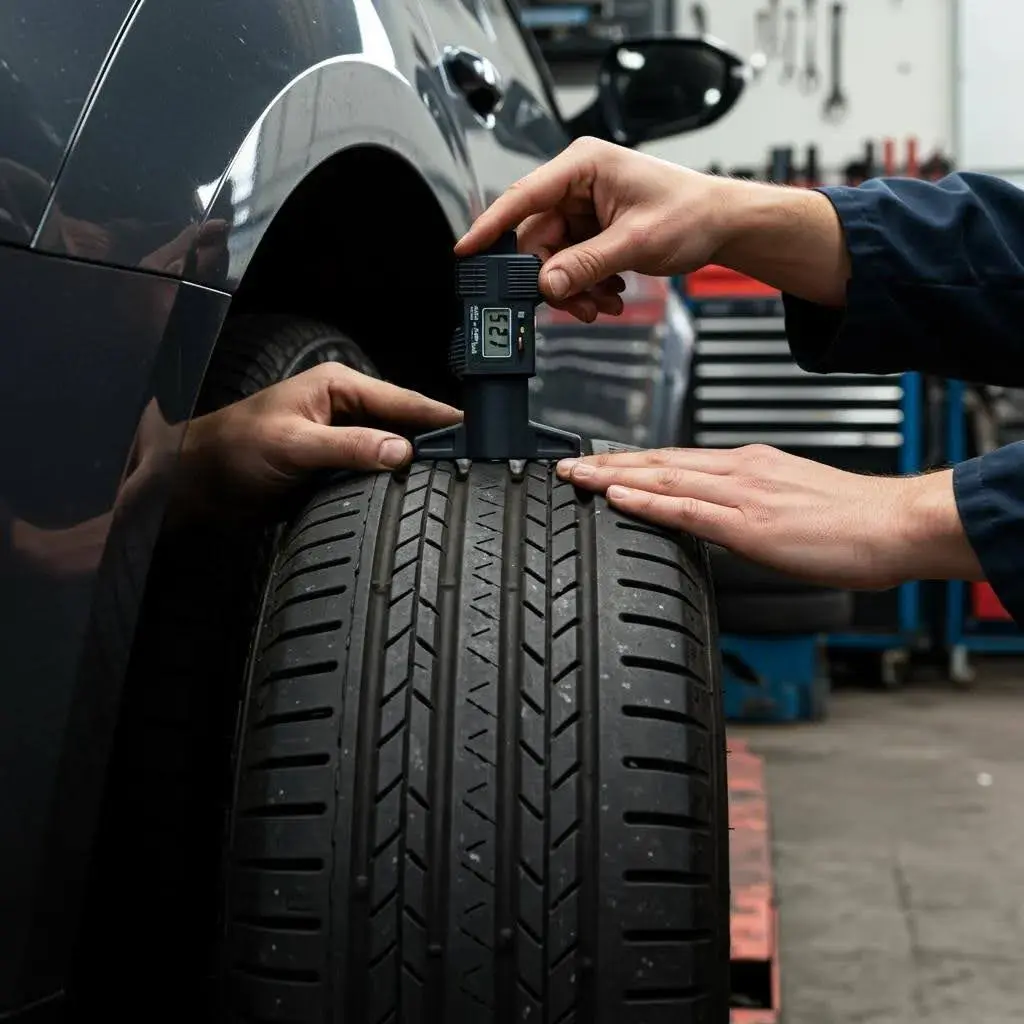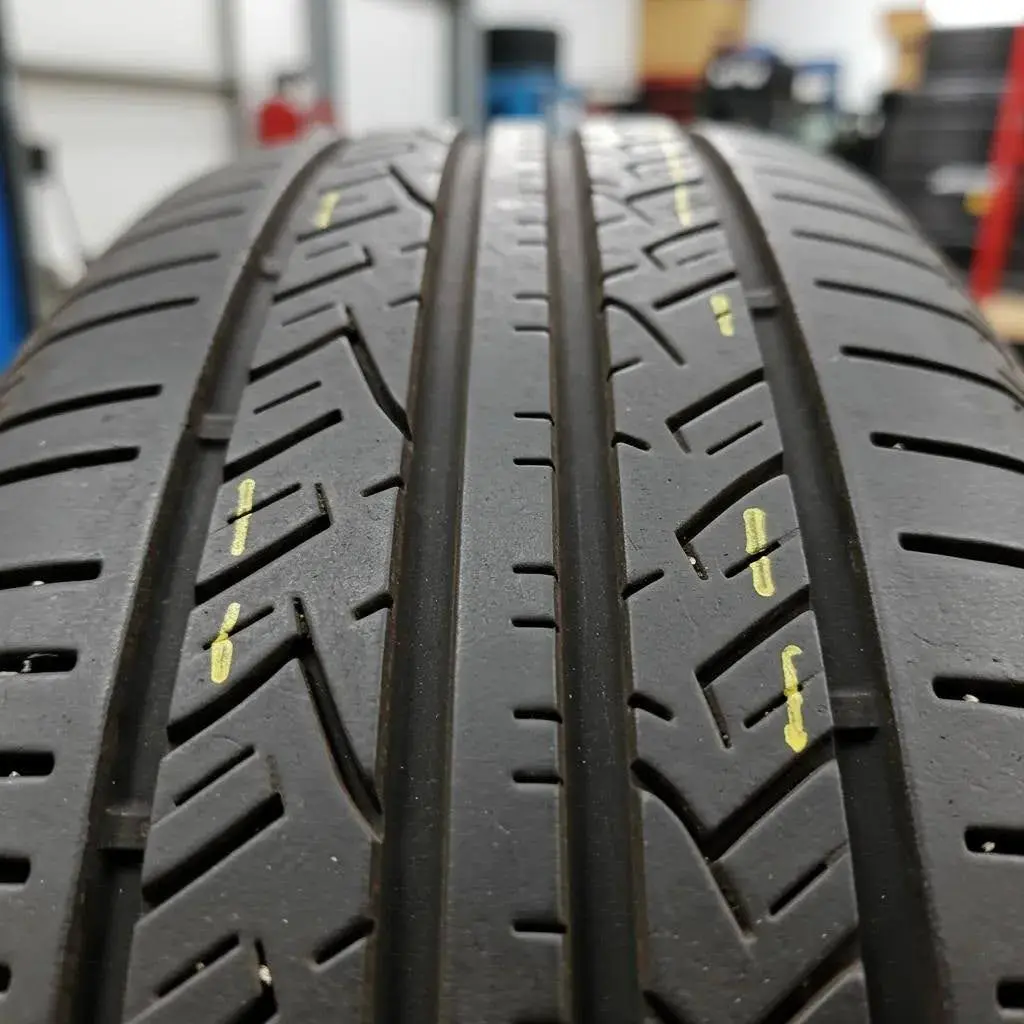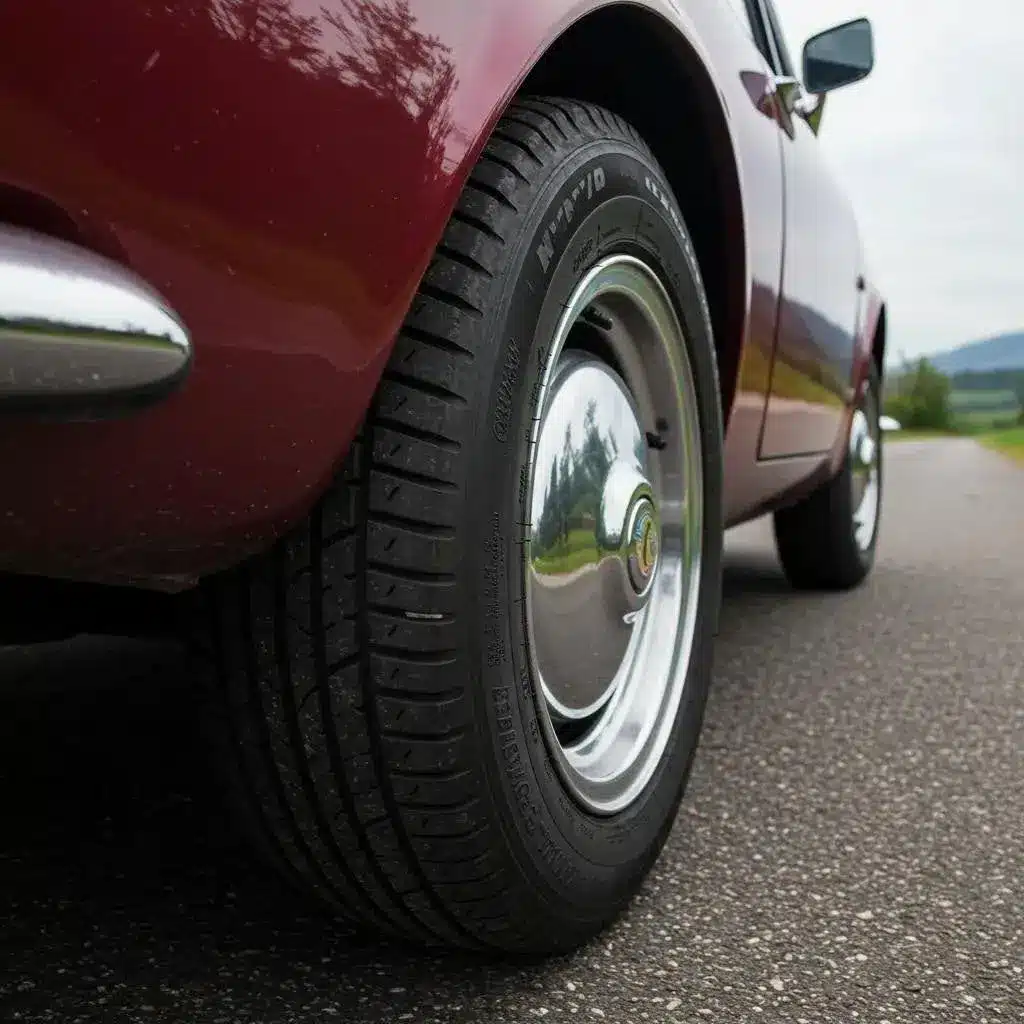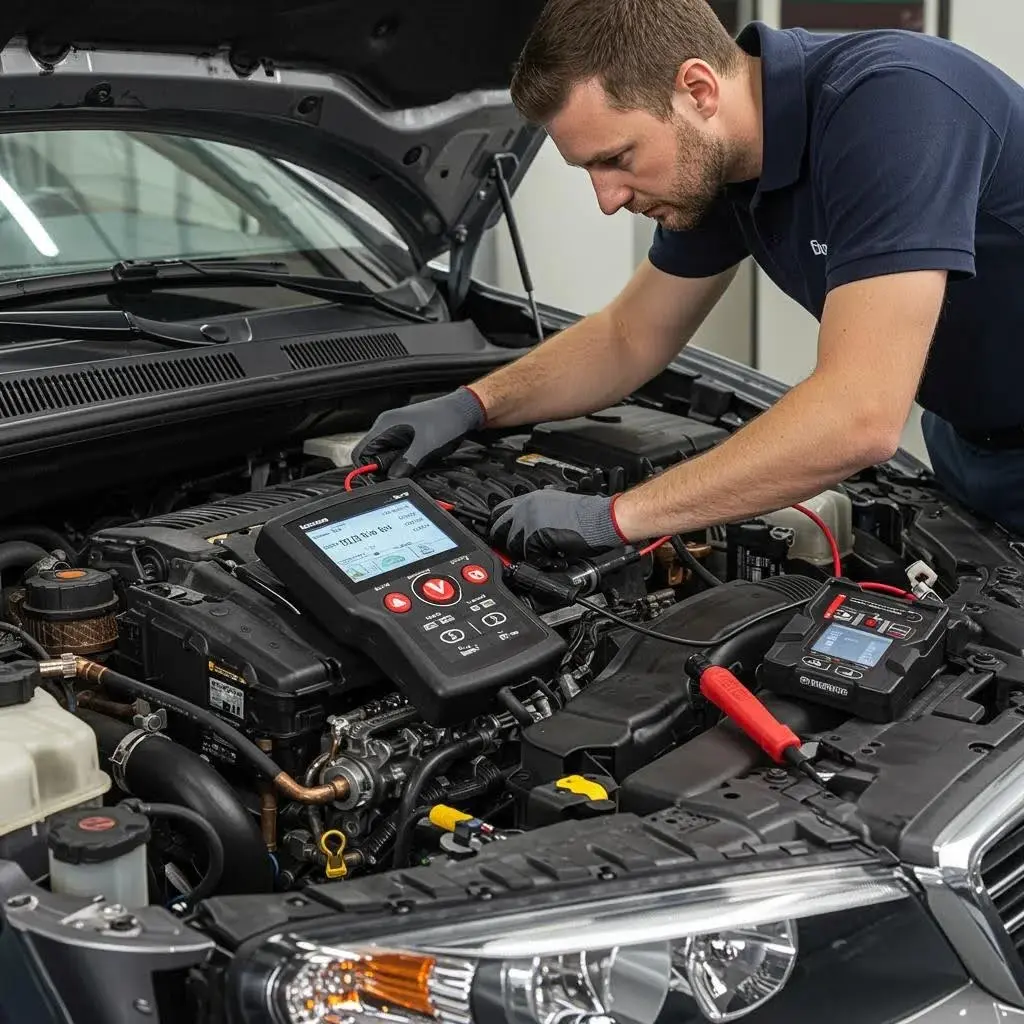
Tyre safety hinges on spotting when wear, damage, or age compromises grip and stability, helping you avoid accidents and failed MOTs. In this guide, you’ll discover UK legal tread limits, visual and physical wear indicators, the impact of age and pressure, plus specialist care for classic cars.
We’ll explain the 20p test, DOT code decoding, TPMS function, rotation benefits, and typical local costs in Tonbridge. Along the way, Sovereign Motor Engineers’ expertise and MOT service at £54.85 help you book a professional inspection or tyre replacement with confidence.
UK Legal Tyre Tread Depth
In the UK, the legal minimum tyre tread depth is 1.6 mm, ensuring adequate water dispersal to prevent aquaplaning and maintain braking performance. Measuring tread depth regularly safeguards against wet-weather skidding and MOT failures, and it aligns with MOT test requirements assessed at Sovereign Motor Engineers’ Tonbridge garage.
The 1.6 mm Legal Tread Depth Limit
The 1.6 mm limit applies to the main grooves across the central three-quarters of the tyre’s width and around its entire circumference. Below this depth, grip deteriorates significantly, especially in wet conditions. Vehicle manufacturers and safety experts recommend replacing tyres before they reach this minimum to preserve handling and fuel economy.
How to Perform the 20p Test to Measure Tyre Tread Depth
The 20p test uses a UK coin as a simple gauge: insert the outer edge of a 20-pence piece into the tread groove. If any part of the coin’s outer band is obscured by the rubber, the tread depth exceeds 1.6 mm. This quick visual check helps drivers monitor wear between professional inspections and avoid illegal tyres on the road.
Tyre Tread Wear Indicators

Tyre Tread Wear Indicators (TWIs) are raised bars moulded into the grooves at intervals around the tyre. When the tread surface becomes level with these bars, it signals the tyre has reached the legal wear limit. TWIs provide a built-in alert system, guiding drivers to replace tyres before safety margins vanish.
How Does the MOT Test Assess Tyre Tread and Condition?
During an MOT, inspectors verify tread depth across the tyre using a gauge and check for uneven wear patterns, bulges, or cuts. Any tyre failing to meet the 1.6 mm minimum or showing structural damage results in a failure.
Sovereign Motor Engineers’ MOT service at £54.85 includes this comprehensive tyre inspection with no-obligation repair estimates if issues arise. Before we look at visual damage, the table below compares common tread-measurement methods and their reliability.
| Measurement Method | Attribute Checked | Reliability |
|---|---|---|
| 20p Test | Groove depth vs coin’s band | Quick and accessible |
| Tread Gauge | Precise mm measurement | Highly accurate |
| Tread Wear Indicator | Built-in legal wear signifier | Automatic and visual |
These methods help drivers maintain legal compliance and optimal tyre performance. Understanding wear indicators sets the stage for spotting other physical signs of deterioration.
Common Signs of Worn or Damaged Tyres
Visual and tactile checks reveal cracks, bulges, uneven wear, and vibrations that indicate a tyre has exceeded safe operating conditions. Recognising these symptoms early prevents blowouts, improves ride comfort, and supports steering precision in varied conditions.
How to Identify Cracks, Bulges, and Sidewall Damage on Tyres
Sidewall cracks appear as fine fissures in the rubber surface, often near the bead or shoulder, caused by UV exposure or ageing. Bulges and blisters indicate internal cord separation from impacts or overloading. Any visible distortion in the sidewall or tread edge requires immediate replacement to avoid sudden failure.
Identifying Uneven Tyre Wear
Uneven wear manifests as scalloped tread edges, cupping, or feathering. Misaligned wheels, faulty suspension, or incorrect tyre pressure cause disproportionate stress on specific tread areas. Identifying these patterns allows targeted wheel alignment or pressure adjustments before tyres wear out prematurely.
How Do Vibrations or Noises Indicate Tyre Problems?
A rhythmic thumping or humming noise at speed often signals a deformed tyre or internal belt separation. Steering wheel vibration can result from uneven tread wear or imbalance. Addressing these symptoms early restores ride smoothness and prevents further mechanical stress.
When to Replace Severely Worn Tyres
When sidewall damage, tread depth below 3 mm, or pronounced wear patterns appear, braking distances increase and handling falters. Many safety organisations advise replacing tyres at or before 3 mm tread depth for superior wet-weather performance. Such severe wear always merits professional inspection and likely replacement.
Tyre Pressure and TPMS in Tyre Safety
Correct inflation pressure supports tyre load-bearing capacity, even wear**, and** optimal grip, reducing rolling resistance and extending service life. Tyre Pressure Monitoring Systems (TPMS) enhance safety by alerting drivers to underinflation, but manual checks remain essential.
Maintaining Correct Tyre Pressure
Proper tyre pressure ensures uniform contact with the road surface, improving braking response and fuel economy. Underinflation increases heat build-up and wear on shoulder edges, while overinflation reduces the contact patch and increases centre wear. Regular checks support balanced performance and tyre longevity.
How Does a Tyre Pressure Monitoring System (TPMS) Work?
TPMS uses direct wheel sensors to measure pressure and temperature or indirect ABS data to detect inflation anomalies. When pressure drops below a threshold, a dashboard warning appears. This alert aids early intervention for underinflation.
TPMS vs. Manual Tyre Pressure Checks
TPMS complements, but does not replace, manual pressure checks. Sensor drift and calibration errors can mask slow leaks, and TPMS cannot measure precise pressure to the nearest tenth of a bar. Combining TPMS alerts with monthly gauge checks ensures accurate inflation management.
How to Reset or Service TPMS in Tonbridge Vehicles
After tyre rotation or replacement, TPMS sensors require recalibration to match current settings. Sovereign Motor Engineers’ technicians reset system thresholds and verify sensor integrity during servicing in Tonbridge.
Professional servicing ensures reliable alerts and accurate pressure monitoring. By managing both tyre wear and inflation, you protect safety and fuel economy on every journey.
How Can Tyre Rotation and Maintenance Extend Tyre Life?
Regular tyre rotation redistributes wear across all four wheels, promoting even tread degradation and maximising mileage. Combined with wheel alignment and balance, rotation schedules create uniform contact conditions that preserve handling and safety.
Benefits of Regular Tyre Rotation
Follow your vehicle manufacturer’s rotation schedule. Regular rotation promotes even wear and may extend tyre life, improve fuel efficiency, and maintain consistent handling in wet and dry conditions.
How Does Wheel Alignment Affect Tyre Wear?
Correct wheel alignment ensures tyres meet the road at optimal camber and toe angles. Misalignment leads to uneven edge wear or feathering, shortening tread life and degrading steering precision. Professional alignment checks during servicing correct these angles and restore a proper contact patch.
How Often Should You Schedule Tyre Maintenance and Inspections?
Industry guidelines recommend tyre rotation and pressure checks at every service interval—typically every 6,000 miles or six months. Detailed visual inspections for damage, tread wear, and pressure form part of Sovereign Motor Engineers’ routine car servicing in Tonbridge.
Special Considerations for Classic Car Tyres
Classic car tyres differ in construction and rubber compounds compared to modern replacements, requiring specialist knowledge to balance authenticity with safety. Vintage tyres often need bespoke sizing and period-correct profiles to preserve handling dynamics.
How Do Classic Car Tyres Differ from Modern Tyres?
Classic tyres typically use bias-ply construction and block tread patterns that suit lower speeds and vintage suspension setups. Modern radial tyres provide superior grip and durability but may alter ride characteristics if fitted to period-correct wheels without adjustment.
Age and Wear Concerns for Vintage Tyres

Rubber compounds in classic tyres degrade over decades, developing brittleness and cracks even if the tread remains intact. Sidewall flexing in bias-ply designs can accelerate cord fatigue, necessitating age-based replacement rather than relying solely on visual tread checks.
How Does Sovereign Motor Engineers Support Classic Car Tyre Care in Tonbridge?
Sovereign Motor Engineers (SME) provides classic car repairs in Tonbridge and can advise on appropriate tyre choices for vintage vehicles. Their experienced team ensures authenticity without compromising modern safety standards.
When Should Classic Car Tyres Be Replaced for Safety and Authenticity?
Many manufacturers recommend replacing tyres within ten years of manufacture and inspecting them after about five years. Matching original tyre profiles and compounds maintains visible authenticity while safeguarding structural integrity on historic vehicles.
Classic car tyre care balances heritage and safety to preserve driving enjoyment and roadworthiness.
How to Book Tyre Inspection and Replacement Services in Tonbridge with Sovereign Motor Engineers?
Booking a professional tyre inspection or replacement in Tonbridge helps ensure legal compliance, enhanced safety, and expert advice tailored to your vehicle. Sovereign Motor Engineers combines local expertise, competitive MOT pricing at £54.85, and an experienced team to deliver reliable service.
Tyre Services Offered by Sovereign Motor Engineers
Sovereign Motor Engineers provides comprehensive tyre repairs, puncture repairs, tyre replacement and fitting, plus wheel alignment, balancing, and condition monitoring. Their MOT service includes mandatory tread depth checks and no-obligation repair estimates.
How to Schedule a Tyre Safety Check or MOT in Tonbridge?
To arrange a tyre inspection or MOT, contact the Tonbridge garage by phone or visit in person to discuss availability. Their team will confirm booking details, advise on required services, and outline any preparatory steps to streamline your visit.
Why Choose Sovereign Motor Engineers for Tyre Replacement and Classic Car Care?
With years of experience in automotive repairs, a team of qualified mechanics, and dedicated expertise in classic vehicles, Sovereign Motor Engineers delivers local trust, high-quality parts, and transparent pricing. Their town-centre location provides convenient access for all car owners in Tonbridge.
During Your Tyre Service Appointment
Your appointment will begin with a detailed visual and car gauge-based inspection, followed by a discussion of findings and recommendations. If replacement is needed, technicians will fit new tyres, balance wheels, and adjust pressures before a final safety check, ensuring your vehicle leaves ready for the road.
Choosing professional inspection and replacement from Sovereign Motor Engineers in Tonbridge helps ensure legal compliance, optimal safety, and peace of mind.
Tyre safety depends on precise tread-depth measurement, regular inspections for wear and damage, age-based replacement, and correct pressure management. By following these guidelines and enlisting Sovereign Motor Engineers’ expertise, you can maintain a reliable grip, avoid MOT failures, and enjoy smoother, safer journeys. Book your tyre check or replacement today to protect your car and passengers on every mile.



